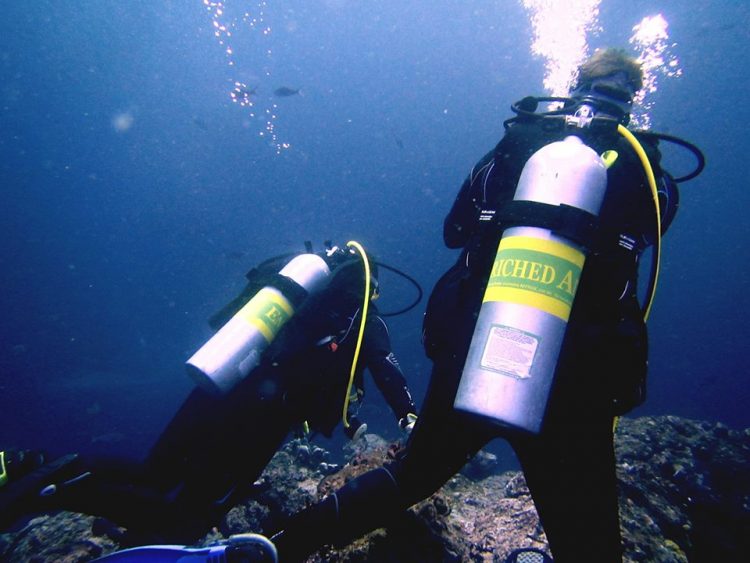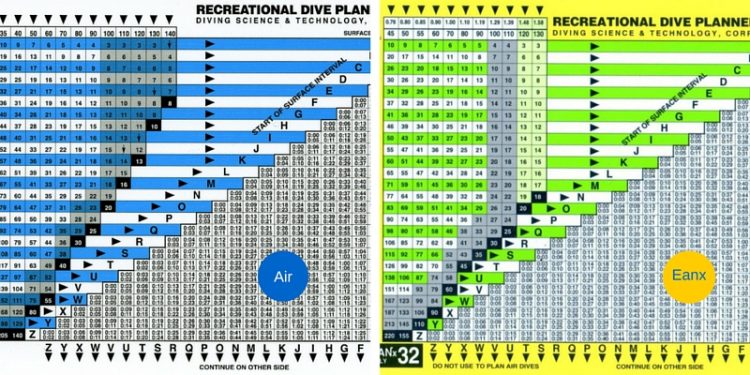Diving with Nitrox? Here’s What You Need to Know to Dive Safe
Divers have been diving with Nitrox for the last 25 year, but there’s still a lot about diving with Nitrox that people don’t understand.
Many people think that diving with Nitrox lets you dive deeper than with regular compressed air, but this is just one of many misconceptions regarding diving with nitrox.

Using nitrox will give you longer bottom time and shorter surface intervals
You’ll need extra training and education about diving with Nitrox before you should use it, but the following facts will give you a basic overview of what it’s all about.
Diving with Nitrox 101
Nitrox is an abbreviation of Nitrogen-Oxygen the primary content of the air we breathe every day. In recreational diving, we use the term Enriched Air Nitrox or EANx, for a breathing gas blend with a higher percentage of oxygen than the usual air we breathe.
In the 1970s, the National Oceanic and Atmospheric Administration (NOAA) established standards for Nitrox diving. They created Nitrox-I containing 32% oxygen and Nitrox-II containing 36% oxygen.
Back then commercial gas blending businesses made these blends available for the early adopters and the recreational diving training agencies adapted the NOAA dive tables and retained the Nitrox-1 and Nitrox-2 percentages as Nitrox-32% and Nitrox-36%. Later these labels became the EAN-32 and EAN-36 we see today.
These days many divers are certified to dive with Nitrox and the costs of blending are much lower making it economically viable for dive centers to start blending nitrox themselves.
[the_ad_group id="1249"]What are the effects of diving with Nitrox?
In the majority of dives, it is the amount of nitrogen that is absorbed that dictates your bottom time or no decompression limit (NDL).
As the pressure increases the deeper, you dive, the nitrogen in the air you breathe dissolves into your bloodstream. Your bottom time is limited as a result of this absorption of nitrogen.
So, as you dive deeper and in some cases longer, your body will absorb more nitrogen. The no-decompression limit will correlate to how much nitrogen your body can safely absorb before you have to perform mandatory decompression stops.
The biggest benefit of diving with enriched air Nitrox is that it will slow down how much nitrogen dissolves into your blood on a dive. This is the result of there being less nitrogen in the mix to be absorbed while you breathe.
Put simply, the higher the percentage of the enriched air Nitrox blend you’re breathing, the more oxygen you have that’s replacing nitrogen.
Death by Nitrox
Even though there are plenty of great benefits that come with diving with Nitrox, you should also be aware of the risks. You should know that, when you breathe oxygen under pressure, it can become toxic, so you may not be able to dive any deeper than you would on regular air.
Remember that 21% is the level of oxygen in the regular air we breathe, and this turns toxic when you reach depths that are greater than the recreational limit. So if you have a higher percentage of oxygen in your nitrox mix, the toxic level can occur even at a shallower depth.
Do you need a specialty training to dive with Nitrox?
Yes, you do! As mentioned before diving with Nitrox does have some additional risks. The more severe is the risk of oxygen toxicity. Under pressure, oxygen can become a toxic and deadly gas.
If you would exceed the 1.6 ATA (a measurement of partial pressure) point when breathing an EANx gas blend your body will start to react, the reactions are rapid and can be fatal. Each diver’s tolerance will to oxygen toxicity will differ, but convulsions that can cause you to lose your regulator and drown are almost guaranteed at 2 ATA.
Feel free to check out our Scuba Dive partners anywhere in the world for (Nitrox) training, packages or guided trips:
[the_ad_group id="1250"]
Symptoms of oxygen toxicity
- Muscle twitching and spasm, notably facial muscles
- Nausea and vomiting
- Dizziness
- Vision (tunnel vision) and hearing
- Difficulties (tinnitus)
- Irritability, confusion, anxiety and a sense of impending doom
- Trouble breathing
- Unusual fatigue
- Incoordination
- Convulsions
Unfortunately, these symptoms and signs may not occur in any particular sequence, and can occur with little or no warning.
Oxygen toxicity won’t be a problem if you adhere to the maximum depth you are trained to dive too. Stay well within your limits at all times!!
Each gas blend has a Maximum Operating Depth (MOD) that you can safely descend to. While 1.6 ATA is the declared safety boundary, most divers use 1.4 ATA in their MOD calculations
On air to reach the 1.6 ATA, you would have to go down approximately 258 feet, which would be a foolish thing to do as you probably would be narced like a drunk hoot owl by the time you reach 150 feet.
1.6 ATA can be reached around 30 meters/100 feet if you are using EAN-38. If you breathed pure oxygen (100%), on a dive you would reach 1.6 ATA in 13 feet, 4 meters.
This why it’s vitally important that you take the right nitrox courses to learn about how to determine the maximum depth you can go to by using the partial pressure and percent of oxygen in the mix you’re using.
Also read: Nitrogen narcosis, what you need to know to keep diving safely
What do you learn in the Enriched Air Nitrox course?
The course covers the understanding and use of:
- Managing oxygen exposure
- How to analyze the content in your tank
- Enriched air tables
- Enriched air compatible equipment
- Gear markings
- Tank filling
- How to use your dive computer for diving with nitrox
Nitrox must be analyzed using a Nitrox analyzer before you use it which you can typically borrow at the dive center. It is your responsibility to analyze your blend and to enter it into an acceptance log. During the nitrox course, you will learn how to do so.
You analyze the gas blend to double check if it contains the mix you requested and you used to plan your dive. When you planned your dive based on an EANX-36 mix and the blend in your tank is EANX-28 you could get in trouble underwater because the maximum-operating depth will be different from previous calculations, so recalculate and plan your dive accordingly.

Nitrox and Air Dive tables
Oxygen can be a dangerous gas
Oxygen quickly oxidizes with other materials that can cause an explosion. And therefore, any scuba gear which will be used to dive with Nitrox should be Nitrox compatible.
When filling tanks with a Nitrox blend, the tank is exposed to pure oxygen that’s diluted later using regular air. If cylinders aren’t treated to withstand this high level of oxygen, they can explode.
Make sure that all parts of your scuba tank that come in contact with pure oxygen are “oxygen clean.” Tanks used for Nitrox and those used for regular air are NOT interchangeable. That’s why a nitrox cylinder will have stickers and decals that make them look different from regular air-filled tanks.
[the_ad_group id="1251"]Why should you consider diving with Nitrox?
Divers prefer to use diving with nitrox for a variety of reasons. One of the primary reasons, though, is because it gives you the ability to stay at depth a bit longer, thanks to the higher no-decompression limit.
Because you’re breathing a lower amount of nitrogen during the dive, your body is absorbing it slower than it normally would. To illustrate this concept, a scuba diver would have a no-decompression limit of about 56 minutes at around 18 meters of 60 feet if he or she were breathing normal air.
If that same scuba diver were using a 36% nitrox mix, even at the same depth, his or her limit would now be 130 minutes. Typically, enriched air blends are best used at depths that range from 50 to 100 feet. If you’re diving in shallower water, the no-decompression limit is so long already that you won’t need to extend it.
Because there’s less nitrogen that you’ll need to off-gas, you can get back into the water more quickly than another diver who dove with you but used regular air. On top that, nitrox can also serve as a safety buffer when used while adhering to normal air tables, profiles, procedures, and computers.
When you plan your dive based on the normal air tables / or air settings on your dive computer and you use Nitrox instead you plan your dive more conservative reducing the risk further of DCS, but keep in mind the MOD of the gas blend you use. The risk with this type of conservative dive planning is that you dive to deep, with nitrox and suffer from oxtox.
Some divers have also reported that diving with enriched air leaves them feeling less tired after a dive, presumably because of the increased oxygen supply to their muscles. Scientists say there is no scientific proof that this happens but agrees it does seem to be true. Another benefit to using nitrox lies in the fact that surface intervals can be shorter too.
There’s an even greater reduction in the risk of getting ill from decompression sickness, so it’s highly valuable to those who are more susceptible to it, including individuals who are older, overweight, injured, fatigued, or have dealt with DCI in the past.
Always remember that nitrox doesn’t improve your air consumption, nor does it give you immunity when it comes to decompression illness.
Always check your gauges, monitor your depth, and restrict yourself to your personal limits just as you would on any other dive with regular air.
Once you’re well versed on the benefits and potential drawbacks of nitrox, you can use it to make the most out of each and every dive by spending more time beneath the waves and less time waiting to get back in the water between dives.
This article is published by The Scuba Page, the online magazine for Scuba Dive lovers around the world. The Scuba Page is part of RUSHKULT: the online booking platform for adventure sports. Visit the RUSHKULT platform to book your next Scuba Dive training, guided trip and accommodation.
[the_ad_group id="1252"]

This was a great review and a point of facts that all divers should always know and reference to